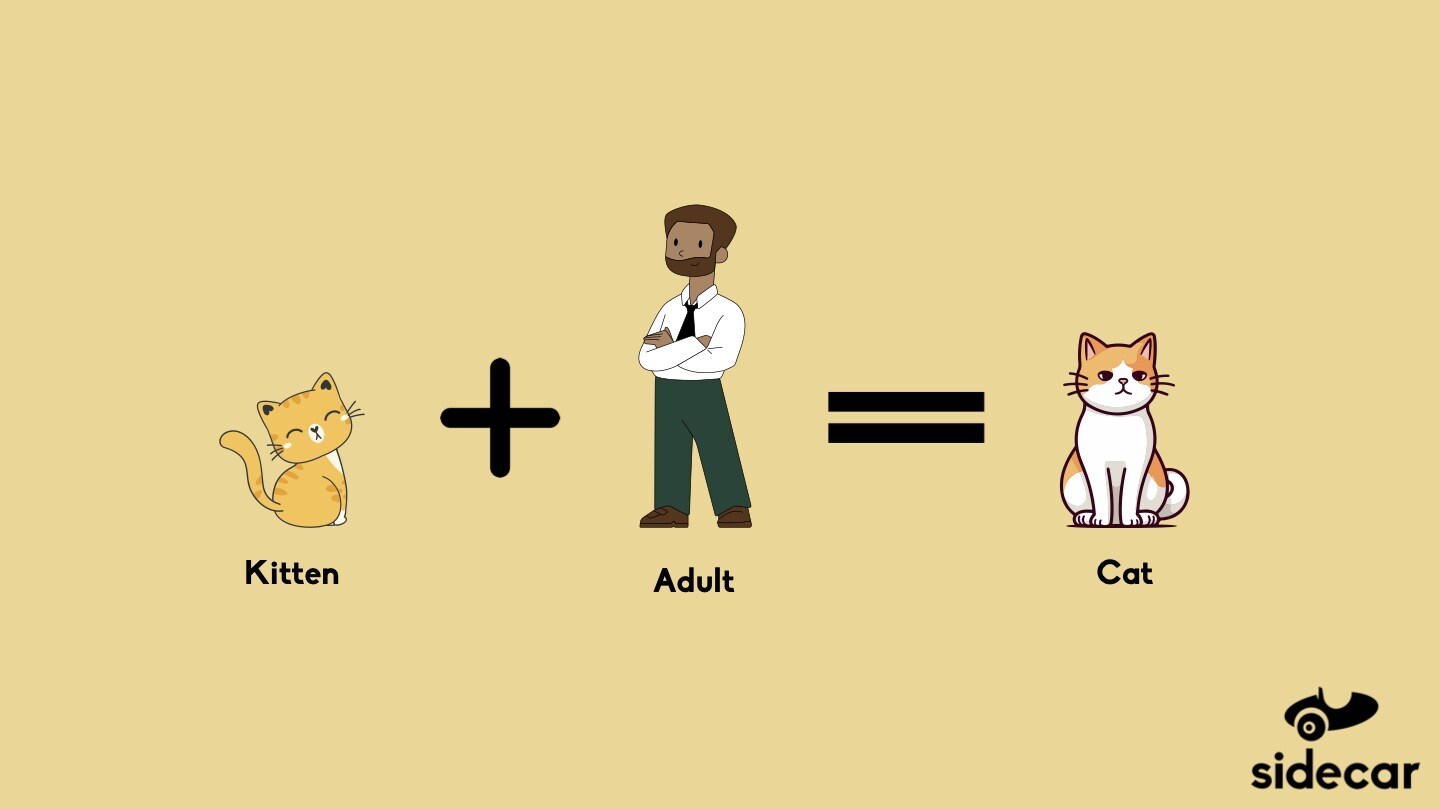AI is revolutionizing most industries, from healthcare to entertainment, by making sense of vast amounts of data. As discussed in our most recent Sidecar Sync podcast episode, two fundamental concepts driving many of these advancements are vectors and embeddings. While these terms may sound technical and intimidating, they play crucial roles in how AI understands and processes information. This guide aims to demystify vectors and embeddings, breaking them down into simple, understandable terms for beginners.
What Are Vectors?
Definition and Basics:
At its core, a vector is a mathematical object that has both a magnitude and a direction. In simpler terms, think of a vector as an arrow pointing from one place to another on a map. This arrow can represent various characteristics, such as distance and direction.
In the context of data, vectors are used to represent different attributes of an object in a multi-dimensional space. For example, consider a simple 2-dimensional space where you plot points based on their length and width. Each point on this graph can be represented as a vector with two dimensions.
Vectors in Data Representation:
Vectors are powerful because they can represent a wide range of attributes simultaneously. For instance, if you want to represent a car, you could use a vector to encode its characteristics, such as speed, color, and engine power. Each of these attributes corresponds to a dimension in the vector space.
Imagine a graph where the x-axis represents the car's speed, the y-axis represents its color, and the z-axis represents its engine power. A point in this 3-dimensional space represents a specific car with a unique combination of speed, color, and engine power.
Introduction to Embeddings
Definition and Purpose:
Embeddings are a type of vector specifically designed to capture the meaning of data. They are generated by AI models that process various types of data, such as text, images, and audio, converting them into numerical vectors. These embeddings are essential for AI to understand and analyze complex data.
Embeddings translate real-world data into a format that machines can work with. For example, in natural language processing, embeddings convert words and sentences into numerical vectors that capture their semantic meaning.
Consider the following example to visualize how vectors can combine attributes of something multidimensional. If you take a vector representing kitten and add the attribute “adult,” you get a vector representing a cat.

Similarly, if you add another attribute “wild” to this vector, it represents a lion.

Creation of Embeddings:
The process of creating embeddings involves training an AI model on a large dataset. This model learns to identify patterns and relationships within the data, allowing it to generate vectors that accurately represent the data's meaning.
For example, an embeddings model trained on a large corpus of text will learn to create vectors for words that capture their semantic relationships. Words with similar meanings, such as "cat" and "feline," will have vectors that are close to each other in the vector space.
How Vectors and Embeddings Work Together
Relationship Between Vectors and Embeddings:
Embeddings are a specific type of vector created by AI models. These embeddings allow AI systems to represent complex data in a simplified, numerical form. By converting data into vectors, AI can perform various operations, such as comparing and clustering data points, to derive insights and make predictions.
As Amith Nagarajan explained in the Sidecar Sync podcast, "Vectors are the basic concept that all these AI systems work on top of." This means that embeddings are foundational to many AI applications, enabling machines to process and understand diverse data types.
Practical Examples:
To illustrate how vectors and embeddings work together, consider the task of image recognition. When an AI model processes an image, it creates an embedding that captures the essential features of the image, such as shapes, colors, and textures. These features are then represented as a vector, allowing the model to compare the image with other images and recognize patterns.
In natural language processing, embeddings are used to represent words and sentences. By converting text into vectors, AI can analyze the semantic relationships between words, enabling tasks such as sentiment analysis, machine translation, and text summarization.
A 2D plot can help visualize how different attributes combine to form new vectors. For example, plotting “adultness” and “wildness” can show how vectors representing a kitten, cat, and lion differ in a multi-dimensional space.

Real-World Applications of Vectors and Embeddings
Content Personalization:
One of the most common applications of vectors and embeddings is content personalization. By analyzing user behavior and preferences, AI can generate vectors that represent individual users and content items. These vectors are then compared to recommend personalized content.
For example, streaming services like Netflix and Spotify use embeddings to recommend movies, TV shows, and songs based on users' past interactions. By comparing vectors of users and content, the AI can identify patterns and preferences, delivering tailored recommendations that enhance the user experience.
Professional Networking:
Vectors can also enhance professional networking by matching individuals with similar interests and complementary skills. For instance, AI-driven recommendation systems can analyze vectors representing members of an association and suggest relevant connections at conferences or events.
In the podcast, Nagarajan highlighted this potential: "We can do recommendations from anything to anything. We can compare and contrast any entity or any object." This means that vectors can facilitate meaningful interactions within professional networks, helping members connect and collaborate more effectively.
Improving Search Functionality:
Search engines and information retrieval systems can benefit from embeddings by improving the relevance of search results. Traditional keyword-based search methods often struggle to understand the context and semantics of queries. Embeddings address this limitation by capturing the meaning of words and phrases.
For example, if you search for "best Italian restaurant," an AI model with embeddings can understand the context and return relevant results, even if the exact keywords are not present in the documents. This results in more accurate and useful search outcomes.
Implementing Vectors and Embeddings in Your Projects
Getting Started:
For beginners looking to work with vectors and embeddings, the first step is to familiarize yourself with the basic concepts. Online tutorials, courses, and documentation can provide valuable insights into how these technologies work.
Next, select beginner-friendly tools and libraries that support vectors and embeddings. Popular choices include TensorFlow and PyTorch, which offer comprehensive resources and community support. These tools simplify the process of creating and working with embeddings, making it accessible even for those with limited technical backgrounds.
Simple Project Ideas:
To gain hands-on experience, consider starting with simple projects that involve vectors and embeddings. Here are a few ideas:
- Text Classification: Build a model that classifies text into different categories, such as spam detection or sentiment analysis. Use embeddings to represent the text data and train the model to recognize patterns.
- Image Similarity: Create a system that finds similar images in a dataset. Use embeddings to represent the images and implement a similarity metric to identify closely related images.
- Recommendation System: Develop a basic recommendation system that suggests items based on user preferences. Use embeddings to represent users and items and implement algorithms to generate personalized recommendations.
Each of these projects will help demonstrate the practical applications of vectors and embeddings, offering a solid foundation for more advanced work.
Conclusion
Vectors and embeddings are key technologies in AI that better enable machines to understand and process complex data. By converting multidimensional data into numerical vectors, AI models can perform various intricate tasks, from content personalization to improving search functionality.
For beginners, understanding these concepts is the first step toward leveraging AI's full potential. By starting with simple projects and using beginner-friendly tools, you can gain valuable experience and insights into how vectors and embeddings work. As you progress, addressing common challenges such as bias and data management will help you create more effective and fair AI systems.
Additional Resources
So... what next?
- Our most recent Sidecar Sync podcast episode From Hackathons to AI Mastery: Understanding Vectors and Embeddings [Sidecar Sync Episode 35] discusses the value of vector databases for associations.
- Interested in getting started with vector databases at your association? Post about it in our Sidecar Community.
- Check out our AI Learning Hub created for associations and nonprofits seeking to enhance their organization with emerging technologies.
By diving into the world of vectors and embeddings, you can unlock new possibilities for your projects and contribute to the exciting advancements in AI. Happy learning!
June 27, 2024

